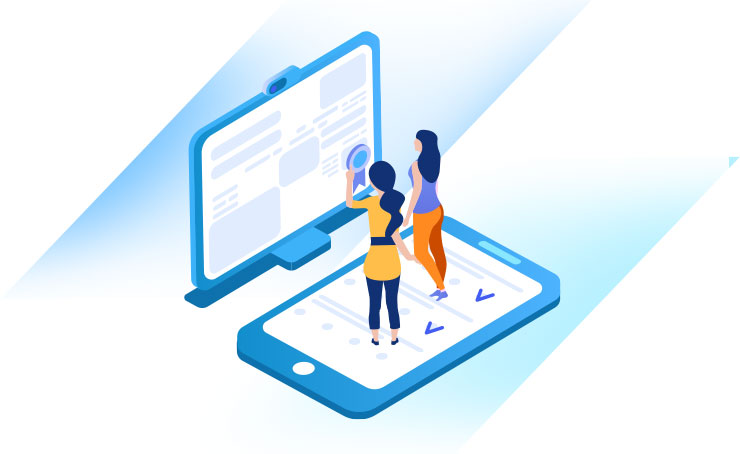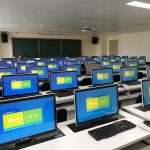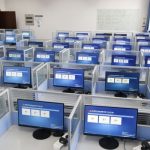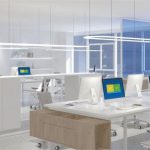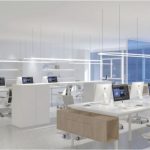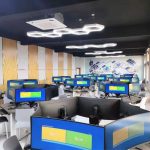Solution Overview
For design-related disciplines, commonly used software includes Autodesk Maya, 3ds Max, UG, SolidWorks, and other 3D design tools. These applications require not only high CPU and memory performance, but also robust GPU capabilities to support teaching in 3D computer labs. The platform offers two solutions—GPU virtualization and distributed cloud desktops—to meet the rendering performance requirements of typical 3D teaching environments.
Solution Architecture Diagram

Solution Details
Distributed Cloud Desktop Based on Local Computing
- Centralized remote management
The system adopts a B/S (Browser/Server) architecture, enabling centralized management of all servers, computers, users, and scenario configurations from the administrator interface. It also supports complex networking environments such as cross-VLAN and cross-subnet deployments, with all management operations functioning identically to those within a local area network.
- Unified Maintenance of Heterogeneous Terminals
The OS-EASY desktop cloud system features intelligent PnP (Plug and Play) driver technology, enabling compatibility with heterogeneous terminals of different batches and hardware configurations. It supports unified management of diverse endpoint devices, allowing a single operating system image to be deployed across all types of PCs. By updating just one image, administrators can efficiently update all terminals, significantly reducing maintenance workload and improving management efficiency.
- Flexible System Deployment
Bare-Metal Deployment for Terminals:The terminal supports bare-metal deployment, allowing it to connect to the server and initiate client installation even without a pre-installed operating system. During system template creation, the platform supports sample machine-based imaging. System distribution supports both BT (BitTorrent) and broadcast modes, as well as intelligent end-to-end data transmission.
The system also supports segmented (disk-level) deployment modes—allowing the simultaneous distribution of both system and data disks, or the independent deployment of the system disk only. This greatly enhances the flexibility of system provisioning and deployment across diverse terminal environments.
- Differential Update
The OS-EASY desktop cloud system supports real-time desktop environment updates without disrupting the teaching process. Administrators only need to update a single client (e.g., install software or modify the OS), and other clients will automatically apply the updated environment upon reboot. The system performs differential updates—only the changed disk data is transmitted—ensuring uninterrupted classroom activities.
- Unified Software Registration
With hardware virtualization technology, the platform enables unified registration of a wide range of software applications, including Ansys, Adams2012, Office, 3ds Max, Maya, UG10, Pro/ENGINEER, SolidWorks, Edius, UGNX, Navisworks 2014, CorelDRAW, and more. This eliminates the need for repetitive manual registration and significantly reduces administrative workload.
- Student Learning Environment Access
The system supports a dual-desktop mode:
Teaching Desktop: Administrators can customize system restore strategies for classroom or training scenarios. It supports batch modification of virtual machine IPs, hostnames, and login credentials—ideal for examination environments. Multiple preconfigured scenes (e.g., WIN7/WIN10) can be created to meet different course requirements.
Personal Desktop: Students log in with account credentials to access their personalized desktops from fixed terminals, enabling mobility and persistence.
Zero Local Resource Consumption & 3D Software Compatibility:The VOI desktop uses disk virtualization technology, allowing disk files to run directly on local terminal hardware. This eliminates the need for a local virtualization layer, resulting in zero local resource overhead. GPU access is handled natively without passthrough, improving compatibility and ensuring smooth performance for 3D software.
- Teaching Assistance
Teaching Cloud Drive:Integrated within the platform, the cloud drive requires no third-party components. A cloud account is automatically generated upon desktop creation. Users can log in to upload and save personal data. The cloud drive can be disabled when not in use to release resources.
Multimedia Interaction:The platform provides self-developed multimedia teaching tools that support screen broadcasting, video broadcasting, file sharing, and electronic roll call. These tools are deeply integrated with the desktop cloud system, allowing teachers to switch desktop environments directly within the teaching interface.
- Desktop Operation & Monitoring
The platform enables behavioral monitoring and control during classroom sessions, helping instructors maintain discipline and improve teaching effectiveness. Behavior policies can be tailored to different professional course requirements.
- Teaching Emergency Recovery
Offline Usage:The system supports offline operation with multiple OS environments. Administrators can push cached OS data in the background, enabling clients to boot and run desktops offline while maintaining restore configurations. This prevents teaching disruptions caused by server or network outages.
USB Rescue:An efficient recovery mechanism is provided that does not rely on the network or administrator intervention. A USB-based rescue system can be easily created for rapid self-service recovery of faulty terminals in just 3 minutes-dramatically reducing O&M workload.
Cloud-Based vGPU Desktop
- Centralized Remote Management Solution
Designed for lab operation and maintenance administrators, the system provides a B/S (Browser/Server) architecture-based management portal with a graphical interface. It can be accessed from any network-connected terminal, enabling centralized management and maintenance of physical servers, virtual machines, terminal devices, and storage systems.
- Batch Deployment Solution
The platform offers linked clone functionality for virtual machines, enabling quick and flexible creation of application environment templates tailored to design-related disciplines. Once a template is prepared, multiple virtual machines with identical configurations can be rapidly cloned and distributed over the network. This supports fast desktop environment deployment and allows seamless switching between different teaching setups within the same lab.
- GPU Virtualization Solution
GPU Sharing Mode:Using a hypervisor-based GPU manager, physical GPU resources are abstracted and shared among multiple virtual desktops, simulating the experience of having a dedicated GPU for each user. This mode is ideal for general applications and users with moderate performance demands.
GPU Passthrough Mode:In this 1:1 mapping model, a dedicated physical GPU is assigned directly to a virtual desktop user. This provides near-native performance, comparable to that of a dedicated workstation or high-end desktop, and is suited for intensive graphical applications.
- Multimedia Interactive Teaching
The platform includes a self-developed multimedia teaching software suite that supports screen broadcasting, video broadcasting, file sharing, and electronic roll call. Deeply integrated with the desktop cloud environment, this tool enables teachers to switch between virtual desktop environments directly through the teaching interface.
- Desktop Operation and Behavior Monitoring
To support diverse classroom requirements across disciplines, the platform enables behavioral monitoring and management on virtual desktops. This helps instructors enhance teaching effectiveness, enforce digital discipline, and ensure a structured learning environment.
- Desktop Self-Maintenance Solution
System Diagnostics: The platform includes an independent diagnostic tool that monitors server status, terminal connectivity, and cluster network conditions. It can automatically generate detection reports and supports one-click repair for identified issues—greatly simplifying routine maintenance operations.
Solution Value
- Improve desktop flexibility
For teachers and students, the platform enables remote, anytime-anywhere access to their desktop environments, delivering a user experience identical to that of a physical PC. Users can instantly access newly provisioned environments, obtain resources on demand, and benefit from a more secure, flexible, and mobile-friendly learning environment.
High-performance virtual desktops can be accessed from any location using any device that meets access requirements—empowering seamless mobile learning and teaching at scale.
- Improved Terminal Compatibility and Scalability
Since all computing tasks in vGPU virtual desktops are handled centrally within the data center, the processing burden on the client side is significantly reduced. As a result, simplified client devices can be widely adopted, offering greater flexibility in terminal selection—including thin clients, all-in-one machines, legacy PCs, and laptops. This accommodates diverse application needs, enables smooth scalability, and lays the foundation for unifying the management of all IT terminal devices across the campus under a single virtualization platform.
- Simplifies IT O&M efficiency by up to 90%
A single cloud platform enables unified construction and management of 3D computer labs. With one web-based management interface, it supports centralized registration of 3D design software and unified deployment, upgrade, and maintenance of graphic workstations, vGPU virtual machines, and servers. This significantly improves the long-term return on IT investment and drives computer-based experimental teaching into the cloud era.
